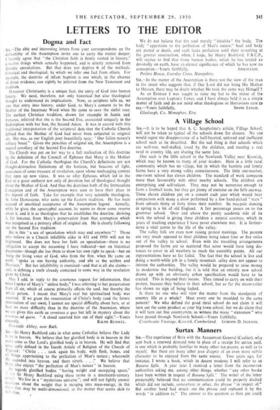LETTERS TO THE EDITOR
Dogma and Fact
sui,—The able and interesting letters from your correspondents on the definability of the Assumption invite one to carry the matter deeper.
heartily agree that " the Christian faith is firmly rooted in history," concerns things which actually happened, and is utterly removed from Gnostic speculations. But that does not deprive It of the methods, historical and theological, by which we infer one fact from others. For example, the doctrine of infant baptism is one which, in the absence of direct evidence, can rightly be inferred frost the New Testament and tradition.
Moreover Christianity is a unique fact, the entry of God into human history. We need, therefore, not only historical but also theological thought to understand its implications. Now, as scripture tells us, we awe that entry into- history, under God, to Mary's consent to be the Mother of the Incarnate Word when He came to save the sinful race. The earliest Christian tradition, shown for example in Justin and Irenaeus, inferred that she is the Second Eve, associated uniquely in the Redemption with her Son, the Second Adam. It was in accord with this traditional interpretation of the scriptural data that the Catholic Church defined that the Mother of God had never been subjected to original sin. She was, as our English poet beautifully says: " Our fallen nature's solitary boast." Given the penalties of original sin, the Assumption is a natural corollary of the Second Eve doctrine.
The Church was put on her way to a full realisation of this doctrine by the definition of the Council of Ephesus that Mary is the Mother of God. For the Catholic theologian the Church's definitions are not thought-destructive limitations of the horizon, but beacons of light, assurances of some treasure of revelation, upon whose unchanging content they open up new vistas. It was so after Ephesus, which led in the East to a great outburst not only of devotion but of theological thought about the Mother of God. And thus the doctrines both of the Immaculate Conception and of the Assumption were seen to have their place in the deposit of faith. Take for example that very scientific theologian, St. John Damascene, who sums up the Eastern tradition. He has been accused of uncritical acceptance of the Assumption legend. Actually, while he gives the apocryphal account, he seems to show some reserve about it, and it is as theologian that he establishes the doctrine, deriving it. for instance, from Mary's preservation from that corruption which was recognised as a primary effect of original sin. He is clearly following out the Second Eve tradition.
But is this " a sea of speculation which may end anywhere "? Those who believe in a Church infallible alike in 431 and 1950 will not be frightened. She does not base her faith on speculation—there is no obligation to accept the reasoning I have indicated—nor on historical documents—though she has them to show her own right to speak—but on being. the living voice of God, who from the first, when He came on earth, " spoke as one having authority, and nibt as the scribes and Pharisees." But her infallibility is exercised—and that is all she claims— only in defining a truth already contained in some way in the revelation given by Christ.
May I add, in reply to the courteous request for information, that when I spoke of Mary's " sinless body," I was referring to her preservation from all sin, which of course primarily affects the soul, but thereby the whole person. I meant that Mary's real but spiritualised body was assumed. If we grant the resurrection of Christ's body (and the future resurrection of our own), I cannot see special difficulty about hers, or at least no more difficulty than in the doctrine of the Ascension, where we are given this earth as terminus a quo but left in mystery about the terminus ad quern. " A cloud received him out of their sight."—Yours
Downside Abbey, near Bath.


























 Previous page
Previous page